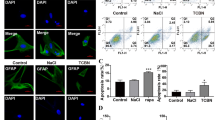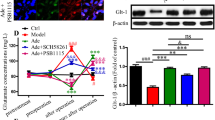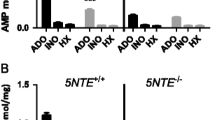Abstract
During ischemia, the operation of astrocytic/neuronal glutamate transporters is reversed and glutamate and Na+ are co-transported to the extracellular space. This study aims to investigate whether this reversed operation of glutamate transporters has any functional meanings for astrocytes themselves. Oxygen/glucose deprivation (OGD) of neuron/astrocyte co-cultures resulted in the massive death of neurons, and the cell death was significantly reduced by treatment with either AP5 or DHK. In cultured astrocytes with little GLT-1 expression, OGD produced Na+ overload, resulting in the reversal of astrocytic Na+/Ca2+-exchanger (NCX). The reversed NCX then caused Ca2+ overload leading to the damage of astrocytes. In contrast, the OGD-induced Na+ overload and astrocytic damage were significantly attenuated in PACAP-treated astrocytes with increased GLT-1 expression, and the attenuation was antagonized by treatment with DHK. These results suggested that the OGD-induced reversal of GLT-1 contributed to the survival of astrocytes themselves by releasing Na+ with glutamate via reversed GLT-1.





Similar content being viewed by others
Abbreviations
- AP5:
-
DL-2-Amino-5-phosphonopentanoic acid, a specific inhibitor of NMDA type glutamate receptors
- CM:
-
Conditioned medium from cells cultured for more than 2 weeks
- DHK:
-
Dihydrokainate, a specific blocker of GLT-1
- EBSS:
-
Earl’s balanced salt solution
- GFAP:
-
Glial fibrillary acidic protein
- LDH:
-
Lactate dehydrogenase
- MAP2:
-
Microtubule-associated protein 2
- NCX:
-
Na+/Ca2+-exchanger
- NADH:
-
Nicotinamide adenine dinucleotide
- OGD:
-
Oxygen/glucose deprivation
- PACAP:
-
Pituitary adenylate cyclase-activating polypeptide
References
Choi DW (1998) Glutamate neurotoxicity and diseases of the nervous system. Neuron 1:623–634
Rothstein JD, Martin L, Levey AI, Dykes-Hoberg M, Jin L, Wu D, Nash N, Kuncl RW (1994) Localization of neuronal and glial glutamate transporters. Neuron 13:713–725
Lees GJ (1991) Inhibition of sodium–potassium-ATPase: a potentially ubiquitous mechanism contributing to central nervous system neuropathology. Brain Res Rev 16:283–300
Szatkowski M, Barbour B, Attwell D (1990) Non-vesicular release of glutamate from glial cells by reversed electrogenic glutamate uptake. Nature 348:443–446
Phillis JW, Smith-Barbour M, Perkins LM, O’Regan MH (1994) Characterization of glutamate, aspartate, and GABA release from ischemic rat cerebral cortex. Brain Res Bull 34:457–466
Levy LM, Warr O, Attwell D (1998) Stoichiometry of the glial glutamate transporter GLT-1 expressed inducibly in a Chinese hamster ovary cell line selected for low endogenous Na+-dependent glutamate uptake. J Neurosci 18:9620–9628
Anderson CM, Swanson RA (2000) Astrocyte glutamate transport: review of properties, regulation, and physiological functions. Glia 32:1–14
Rose CR, Waxman SG, Ransom BR (1998) Effects of glucose deprivation, chemical hypoxia, and simulated ischemia on Na+ homeostasis in rat spinal cord astrocytes. J Neurosci 18:3554–3562
Jabaudon D, Scanziani M, Gähwiler BH, Gerber U (2000) Acute decrease in net glutamate uptake during energy deprivation. Proc Natl Acad Sci USA 97:5610–5615
Takahashi S, Shibata M, Gotoh J, Fukuuchi Y (2000) Astroglial cell death induced by excessive influx of sodium ions. Eur J Pharmacol 408:127–135
Kawahara K, Hosoya R, Sato H, Tanaka M, Nakajima T, Iwabuchi S (2002) Selective blockade of astrocytic glutamate transporter GLT-1 with dihydrokainate prevents neuronal death during ouabain treatment of astrocyte/neuron co-cultures. Glia 40:337–349
Kawahara K, Yanoma J, Tanaka M, Nakajima T, Kosugi T (2004) Nitric oxide produced during ischemia is toxic but crucial to preconditioning-induced ischemic tolerance of neurons in culture. Neurochem Res 29:797–804
Kawahara K, Kosugi T, Tanaka M, Nakajima T, Yamada T (2005) Reversed operation of glutamate transporter GLT-1 is crucial to the development of preconditioning-induced ischemic tolerance of neurons in neuron/astrocyte co-cultures. Glia 49:349–359
Kawahara K, Abe R, Yamauchi Y, Kohashi M (2002) Fluctuations of contraction rhythm during simulated ischemia/reperfusion in cultured cardiac myocytes from neonatal rats. Biol Rhythm Res 33:339–350
Maguire G, Simko H, Weinreb RN, Ayoub G (1998) Transport-mediated release of endogenous glutamate in the vertebrate retina. Pflügers Arch 436:481–484
Innocenti B, Parpura V, Haydon PG (2000) Imaging extracellular waves of glutamate during calcium signaling in cultured astrocytes. J Neurosci 20:1800–1808
Goldberg MP, Choi DW (1993) Combined oxygen and glucose deprivation in cortical cell culture: calcium-dependent and calcium-independent mechanisms of neuronal injury. J Neurosci 13:3510–3524
Zelenaia O, Schlag BD, Gochenauer GE, Ganel R, Song W, Beesley JS, Grinspan JB, Rothstein JD, Robinson MB (2000) Epidermal growth factor receptor agonists increase expression of glutamate transporter GLT-1 in astrocytes through pathways dependent on phosphatidylinositol 3-kinase and transcroption factor NF-κB. Mol Pharmacol 57:667–678
Figiel M, Maucher T, Rozyczka J, Bayatti N, Engele J (2003) Regulation of glial glutamate transporter expression by growth factors. Exp Neurol 183:124–135
Figiel M, Engele J (2000) Pituitary adenylate cyclase-activating polypeptide (PACAP), a neuron-derived peptide regulating glial glutamate transport and metabolism. J Neurosci 20:3596–3605
Robinson MB (1998) The family of sodium-dependent glutamate transporters: a focus on the GLT-1/EAAT2 subtype. Neurochem Int 33:479–491
Rao VL, Dogan A, Bowen KK, Todd KG, Dempsey RJ (2001) Antisense knockdown of the glial glutamate transporter GLT-1, but not the neuronal glutamate transporter EAAC1, exacerbates transient focal cerebral ischemia-induced neuronal damage in rat brain. J Neurosci 21:1876–1883
Satoh H, Ginsburg KS, Qing K, Terada H, Hayashi H, Bers DM (2000) KB-R7943 block of Ca2+ influx via Na+/Ca2+ exchange does not alter twitches or glycoside inotropy but prevents Ca2+ overload in rat ventricular myocytes. Circulation 101:1441–1446
Nedergaad M (1994) Direct signaling from astrocytes to neurons in cultures of mammalian brain cells. Science 263:1768–1771
Florio T, Grimaldi M, Scorziello A, Salmona M, Bugiani O, Tagliavini F, Forloni G, Schettini A (1996) Intracellular calcium rise through L-type calcium channels, as molecular mechanism for prion protein fragment 106–126-induced astroglial proliferation. Biochem Biophys Res Commun 228:397–405
Quandt FN, Macvicar BA (1986) Calcium activated potassium channels in cultured astrocytes. Neuroscience 19:29–41
Parpura V, Basarsky TA, Liu F, Jeftinija S, Haydon PG (1994) Glutamate-mediated astrocyte-neuron signalling. Nature 369:744–747
Arakawa N, Sakaue M, Yokoyama I, Hashimoto H, Koyama Y, Baba A, Matsuda T (2000) KB-R7943 inhibits store-operated Ca2+ entry in cultured neurons and astrocytes. Biochem Biophys Res Commun 279:354–357
Mitani A, Tanaka K (2003) Functional changes of glial glutamate transporter GLT-1 during ischemia: an in vivo study in the hippocampal CA1 of normal mice and mutant mice lacking GLT-1. J Neurosci 23:7176–7182
Rothstein JD, Dykes-Hoberg M, Pardo CA, Bristol LA, Jin L, Kuncle RW, Kanai Y, Hediger MA, Wang Y, Schielke JP, Welty DF (1996) Knockout of glutamate transporters reveals a major role for astroglial transport in excitotoxicity and clearance of glutamate. Neuron 16:675–686
Tanaka K, Watase K, Manabe T, Yamada K, Watanabe M, Takahashi K, Iwama H, Nishikawa T, Ichihara N, Kikuchi T, Okuyama S, Kawashima N, Hori S, Takimoto M, Wada K (1997) Epilepsy and exacerbation of brain injury in mice lacking the glutamate transporter GLT-1. Science 276:1699–1702
Sontheimer H, Ritchie JM (1995) Voltage-gated sodium and calcium channels. In: Kettenmann H, Ransom BR (eds) Neuroglia. Oxford University Press, New York, pp 202–220
Choi DW, Rothman SM (1990) The role of glutamate neurotoxicity in hypoxic-isocheims neuronal death. Annu Rev NeuroSci 13:171–182
Acknowledgment
The authors wish to thank Dr. Takayuki Nakajima, Research Institute for Electronic Science, Hokkaido University, for advice on the immunostaining of cortical cultures.
Author information
Authors and Affiliations
Corresponding author
Rights and permissions
About this article
Cite this article
Kosugi, T., Kawahara, K. Reversed Actrocytic GLT-1 during Ischemia is Crucial to Excitotoxic Death of Neurons, but Contributes to the Survival of Astrocytes themselves. Neurochem Res 31, 933–943 (2006). https://doi.org/10.1007/s11064-006-9099-6
Accepted:
Published:
Issue Date:
DOI: https://doi.org/10.1007/s11064-006-9099-6




